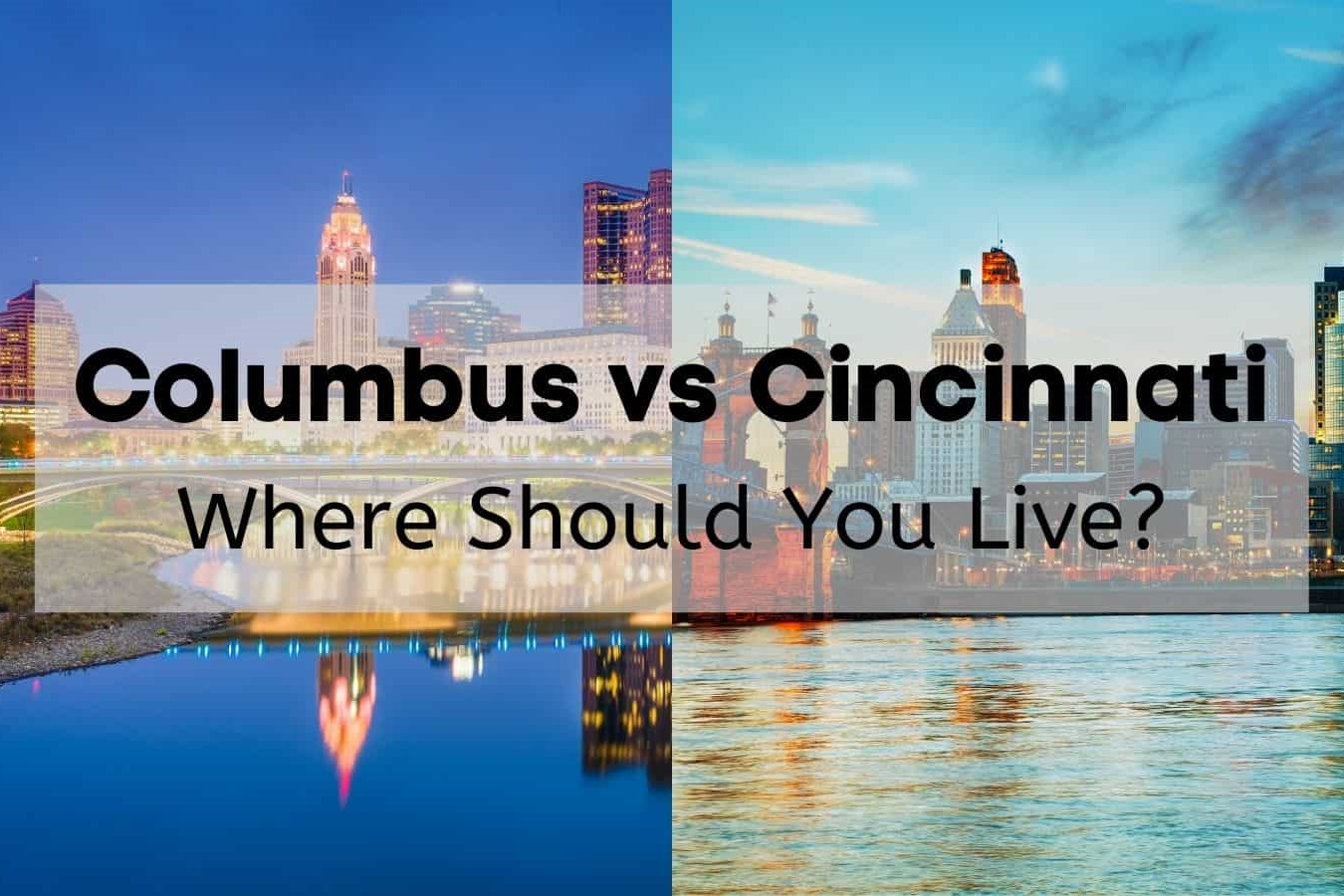Home>Travel and Places>Cincinnati Vs Columbus: Which Ohio City Reigns Supreme?


Travel and Places
Cincinnati Vs Columbus: Which Ohio City Reigns Supreme?
Published: February 11, 2024
Discover the best of Ohio with our guide to Cincinnati and Columbus. Explore top attractions, dining, and entertainment to plan your next travel adventure.
(Many of the links in this article redirect to a specific reviewed product. Your purchase of these products through affiliate links helps to generate commission for Noodls.com, at no extra cost. Learn more)
Table of Contents
Introduction
Ohio, a state known for its rich history, vibrant culture, and diverse cities, is home to two prominent urban centers: Cincinnati and Columbus. These cities, each with its own unique charm and allure, offer a plethora of attractions and opportunities for residents and visitors alike. As we delve into the comparison between Cincinnati and Columbus, we will explore various aspects such as history, culture, economy, education, outdoor activities, and transportation infrastructure. By shedding light on the distinctive features of these cities, we aim to provide valuable insights to help you determine which Ohio city reigns supreme in your eyes. Let's embark on this journey to uncover the essence of Cincinnati and Columbus, and discover the factors that set them apart as exceptional destinations within the Buckeye State.
History and Background
Cincinnati and Columbus, two of Ohio's most prominent cities, boast rich histories that have significantly shaped their identities. Cincinnati, often referred to as the "Queen City," was founded in 1788 and quickly emerged as a key river port and industrial hub along the Ohio River. Its strategic location facilitated trade and commerce, propelling the city into a position of economic prominence during the 19th century. The city's historical significance is evident in its well-preserved architecture, including stunning 19th-century buildings and charming neighborhoods that exude a timeless appeal.
In contrast, Columbus, the state capital, has a more recent origin, having been established in 1812. Initially, it was a relatively modest settlement, but its status was elevated when it was chosen as the capital of Ohio in 1816. This decision catalyzed the city's growth and development, leading to the establishment of government institutions, educational facilities, and cultural landmarks. Today, Columbus stands as a testament to urban planning and modern development, with a skyline that reflects its status as a thriving metropolis.
Both cities have played pivotal roles in the state's history, with Cincinnati's legacy deeply intertwined with its industrial prowess and river trade, while Columbus has evolved into a dynamic center for governance, education, and innovation. Understanding the historical underpinnings of these cities provides a glimpse into their evolution and the factors that have contributed to their distinct characters. As we continue our exploration, we will delve into the cultural tapestries, economic landscapes, and educational ecosystems of Cincinnati and Columbus, further unraveling the unique attributes that define these Ohio urban centers.
Culture and Entertainment
Culture and entertainment thrive in both Cincinnati and Columbus, offering residents and visitors a diverse array of experiences that cater to various interests and preferences.
In Cincinnati, the city's cultural tapestry is woven with a rich blend of heritage, arts, and culinary delights. The Over-the-Rhine district stands as a testament to the city's vibrant culture, with its historic architecture, trendy boutiques, and a burgeoning culinary scene. This neighborhood, once known for its German immigrant population, has evolved into a hub for creativity and artistic expression, housing numerous art galleries, performance spaces, and artisanal eateries. Additionally, the Cincinnati Art Museum, renowned for its extensive collection spanning thousands of years, provides a captivating journey through world art and history. The city's commitment to the performing arts is evident in the Aronoff Center for the Arts, a premier venue for theater, dance, and musical performances.
Meanwhile, Columbus boasts a dynamic cultural landscape, with a strong emphasis on innovation and creativity. The Short North Arts District stands out as a vibrant enclave, teeming with galleries, studios, and street art that reflect the city's avant-garde spirit. The district's monthly Gallery Hop event draws art enthusiasts and revelers, offering a lively atmosphere filled with artistic showcases, live music, and culinary delights. Furthermore, the city's commitment to fostering creativity is exemplified by the Columbus Museum of Art, which houses an impressive collection of American and European masterpieces, as well as contemporary works that push the boundaries of artistic expression.
When it comes to entertainment, both cities offer an eclectic mix of options to suit diverse tastes. Cincinnati's historic Fountain Square serves as a focal point for community gatherings and events, hosting concerts, festivals, and seasonal celebrations throughout the year. The city's professional sports teams, including the Cincinnati Reds and the Cincinnati Bengals, draw fervent crowds of fans, adding to the city's vibrant sporting culture. In Columbus, the Arena District stands as a premier entertainment destination, featuring a dynamic blend of dining, nightlife, and live entertainment venues. The district's proximity to the Nationwide Arena ensures a steady stream of concerts, sporting events, and family-friendly shows, catering to a wide audience.
In essence, both Cincinnati and Columbus offer a rich tapestry of cultural experiences and entertainment options, each contributing to the unique allure of these Ohio cities. Whether one seeks artistic inspiration, culinary delights, or lively entertainment, both cities stand ready to captivate and delight visitors with their distinct cultural offerings.
Economy and Job Opportunities
The economic landscapes of Cincinnati and Columbus are characterized by diverse industries, robust job markets, and a spirit of innovation that fuels growth and opportunity.
Cincinnati's economy is marked by a rich tapestry of industries, including advanced manufacturing, healthcare, consumer goods, and professional services. The city's strategic location along major transportation routes, including the Ohio River, has historically facilitated trade and commerce, contributing to its status as a regional economic powerhouse. Notably, Cincinnati is home to a thriving healthcare sector, with renowned institutions such as the University of Cincinnati Medical Center and Cincinnati Children's Hospital Medical Center driving innovation and providing employment opportunities in medical research, patient care, and healthcare administration. Additionally, the city's manufacturing sector continues to evolve, embracing advanced technologies and processes to maintain its competitive edge in the global market. The presence of major corporations, including Procter & Gamble, Kroger, and General Electric, further underscores Cincinnati's position as a hub for corporate headquarters and business operations, offering a wide array of job opportunities across various sectors.
In contrast, Columbus has emerged as a dynamic economic center, driven by a diverse range of industries and a burgeoning entrepreneurial ecosystem. The city's economy is anchored by sectors such as finance, insurance, healthcare, education, and technology, with a growing emphasis on innovation and research. Columbus' status as the state capital has fostered a robust government sector, providing employment opportunities in public administration, policy development, and regulatory affairs. Moreover, the city's thriving healthcare industry, represented by institutions like OhioHealth and Nationwide Children's Hospital, contributes to job creation and economic growth. Columbus' reputation as a technology and research hub is bolstered by the presence of The Ohio State University, a renowned institution that fuels innovation and talent development, creating a fertile ground for job opportunities in research, technology, and academia. The city's commitment to fostering entrepreneurship and innovation is evident in initiatives such as the Smart Columbus program, which aims to drive sustainable growth and create job opportunities in the emerging field of smart mobility and infrastructure.
In summary, both Cincinnati and Columbus offer dynamic economic landscapes characterized by diverse industries, robust job markets, and a spirit of innovation that fuels growth and opportunity. Whether one seeks employment in healthcare, manufacturing, technology, or finance, both cities present a wealth of job opportunities and a conducive environment for professional growth and advancement.
Education and Research
Education and research form the bedrock of intellectual and innovative pursuits in any thriving community. In Cincinnati, a rich tapestry of educational institutions and research initiatives contributes to the city's intellectual vibrancy and knowledge-driven progress. The presence of esteemed universities such as the University of Cincinnati and Xavier University underscores the city's commitment to academic excellence and knowledge dissemination. These institutions offer a diverse array of academic programs, ranging from liberal arts and sciences to engineering, business, and healthcare disciplines, catering to a broad spectrum of educational aspirations.
Moreover, the University of Cincinnati's strong emphasis on research and innovation has led to groundbreaking discoveries and advancements in fields such as medicine, engineering, and environmental science. The university's collaborative partnerships with industry stakeholders and government entities further amplify its impact, fostering a culture of interdisciplinary research and knowledge transfer that extends beyond the confines of academia.
Similarly, Columbus stands as a beacon of educational and research excellence, propelled by the presence of The Ohio State University, a renowned institution with a global reputation for academic prowess and research innovation. The university's comprehensive academic offerings span diverse disciplines, encompassing fields such as agriculture, business, engineering, and the arts, providing students with a fertile ground for intellectual exploration and skill development.
The Ohio State University's robust research initiatives encompass a wide spectrum of domains, including healthcare, sustainability, technology, and social sciences, driving transformative discoveries and solutions that address pressing societal challenges. The university's collaborative endeavors with industry partners and government agencies amplify the impact of its research endeavors, fostering an ecosystem of innovation and knowledge creation that transcends traditional boundaries.
In essence, both Cincinnati and Columbus stand as bastions of educational excellence and research innovation, offering a wealth of academic opportunities and intellectual resources that nurture the minds of future leaders and innovators. The cities' commitment to fostering a culture of learning, discovery, and collaboration underscores their pivotal roles as centers of knowledge and innovation within the state of Ohio.
Outdoor Activities and Recreation
Outdoor enthusiasts and nature lovers will find an abundance of opportunities to immerse themselves in the natural splendor of both Cincinnati and Columbus.
In Cincinnati, the city's picturesque location along the Ohio River offers a gateway to a myriad of outdoor activities. The sprawling network of parks, including the scenic Eden Park and the expansive Mount Airy Forest, provides ample space for hiking, picnicking, and nature exploration. Adventure seekers can revel in the thrill of kayaking and canoeing along the tranquil waters of the Little Miami River, immersing themselves in the serene beauty of the surrounding landscape. Furthermore, the Cincinnati Nature Center and the nearby Red River Gorge Geological Area beckon outdoor enthusiasts with their diverse ecosystems, offering opportunities for birdwatching, wildlife observation, and immersive nature trails that showcase the region's natural heritage.
Meanwhile, Columbus boasts an array of outdoor recreational spaces that cater to diverse interests and activities. The Scioto Mile, a stunning urban oasis nestled along the Scioto River, provides a scenic backdrop for leisurely strolls, cycling, and outdoor yoga sessions, allowing visitors to unwind amidst the city's vibrant waterfront. Additionally, the extensive network of trails, including the Olentangy Greenway Trail and the Alum Creek Greenway Trail, beckons cyclists, joggers, and nature enthusiasts to embark on invigorating journeys through picturesque landscapes and serene woodlands. For those seeking a tranquil retreat, the Franklin Park Conservatory and Botanical Gardens offer a captivating escape into lush gardens, vibrant floral displays, and immersive horticultural experiences that celebrate the beauty of nature.
Both cities also offer ample opportunities for outdoor sports and recreational pursuits. Cincinnati's devotion to sports and outdoor activities is exemplified by the presence of the Great American Ball Park, home to the Cincinnati Reds, where baseball aficionados can revel in the excitement of live games and spirited camaraderie. Similarly, Columbus' fervent sporting culture is showcased through the iconic Ohio Stadium, where passionate fans gather to cheer on the Ohio State Buckeyes, fostering a sense of community and sportsmanship that resonates throughout the city.
In essence, both Cincinnati and Columbus stand as gateways to a wealth of outdoor activities and recreational experiences, inviting residents and visitors to embrace the natural wonders and dynamic outdoor pursuits that define the essence of these Ohio urban centers. Whether one seeks tranquility amidst scenic landscapes, the thrill of outdoor adventures, or the camaraderie of sporting events, both cities offer a tapestry of outdoor experiences that celebrate the beauty of nature and the spirit of outdoor recreation.
Transportation and Infrastructure
Efficient transportation and robust infrastructure are vital components that shape the connectivity and accessibility of urban centers. In the context of Cincinnati and Columbus, these elements play pivotal roles in facilitating mobility, fostering economic growth, and enhancing the overall quality of life for residents and visitors.
Cincinnati's transportation network encompasses a diverse array of options, catering to the varied needs of its populace. The city's Metro bus system, complemented by the Cincinnati Bell Connector streetcar, provides reliable public transit services that connect key neighborhoods, business districts, and cultural hubs. Additionally, the city's commitment to sustainable mobility is evident in initiatives such as Red Bike, a bike-sharing program that promotes eco-friendly transportation and enhances connectivity within the urban core. Furthermore, Cincinnati's strategic location at the confluence of major interstate highways, including I-71 and I-75, ensures seamless connectivity with regional and national transportation arteries, facilitating the movement of goods and people.
In contrast, Columbus boasts a comprehensive transportation infrastructure that supports the city's dynamic growth and urban development. The Central Ohio Transit Authority (COTA) operates an extensive bus network, offering convenient and accessible public transit options that serve diverse neighborhoods and employment centers. The city's commitment to enhancing mobility is exemplified by initiatives such as the Smart Columbus program, which focuses on innovative transportation solutions, including electric vehicle adoption, intelligent transportation systems, and sustainable urban mobility strategies. Furthermore, Columbus' strategic positioning at the intersection of major highways, such as I-70 and I-71, ensures efficient connectivity with regional and national transportation corridors, bolstering the city's role as a pivotal transportation hub within the state.
Both cities have made significant investments in infrastructure, with ongoing projects aimed at modernizing transportation systems, enhancing road networks, and promoting sustainable mobility solutions. Cincinnati's iconic Roebling Suspension Bridge, a historic landmark that spans the Ohio River, stands as a testament to the city's engineering prowess and enduring infrastructure. Similarly, Columbus' commitment to infrastructure development is showcased through initiatives such as the Smart Columbus Transportation Operating System, which leverages data-driven insights to optimize traffic flow, improve safety, and enhance the overall efficiency of the city's transportation network.
In essence, Cincinnati and Columbus stand as exemplars of urban centers with robust transportation systems and forward-looking infrastructure that cater to the evolving needs of their communities. The cities' dedication to enhancing mobility, embracing sustainable transportation solutions, and fostering infrastructure innovation underscores their roles as vibrant and accessible destinations within the state of Ohio.
Conclusion
In conclusion, the comparison between Cincinnati and Columbus reveals two distinct urban landscapes, each with its own unique blend of history, culture, economic vitality, educational excellence, outdoor splendor, and robust infrastructure. Cincinnati, with its rich industrial heritage, vibrant arts scene, and strategic location along the Ohio River, exudes a timeless charm that resonates with history enthusiasts, art aficionados, and nature lovers alike. The city's commitment to fostering cultural diversity, promoting artistic expression, and preserving its architectural legacy underscores its status as a cultural and historical gem within the state of Ohio.
On the other hand, Columbus, as the dynamic state capital, embodies a spirit of innovation, academic prowess, and forward-looking urban development. The city's thriving economy, anchored by diverse industries and a burgeoning entrepreneurial ecosystem, offers a fertile ground for professional growth and opportunity. Columbus' dedication to fostering educational excellence, driving research innovation, and embracing sustainable urban mobility solutions positions it as a hub for intellectual exploration, technological advancement, and inclusive urban living.
Ultimately, the choice between Cincinnati and Columbus hinges on individual preferences, aspirations, and lifestyle priorities. Whether one seeks the timeless allure of historic neighborhoods and artistic enclaves or the dynamic energy of a modern metropolis with a thriving innovation ecosystem, both cities offer a wealth of experiences and opportunities that cater to diverse interests and ambitions.
As we reflect on the essence of Cincinnati and Columbus, it becomes evident that these Ohio urban centers, while distinct in their characteristics, share a common thread of vitality, resilience, and a commitment to fostering vibrant communities. Whether one finds inspiration in Cincinnati's historic landmarks and cultural enclaves or embraces the forward-looking spirit of innovation and academic excellence in Columbus, both cities stand as testaments to the enduring allure and dynamic evolution of urban life within the Buckeye State.














